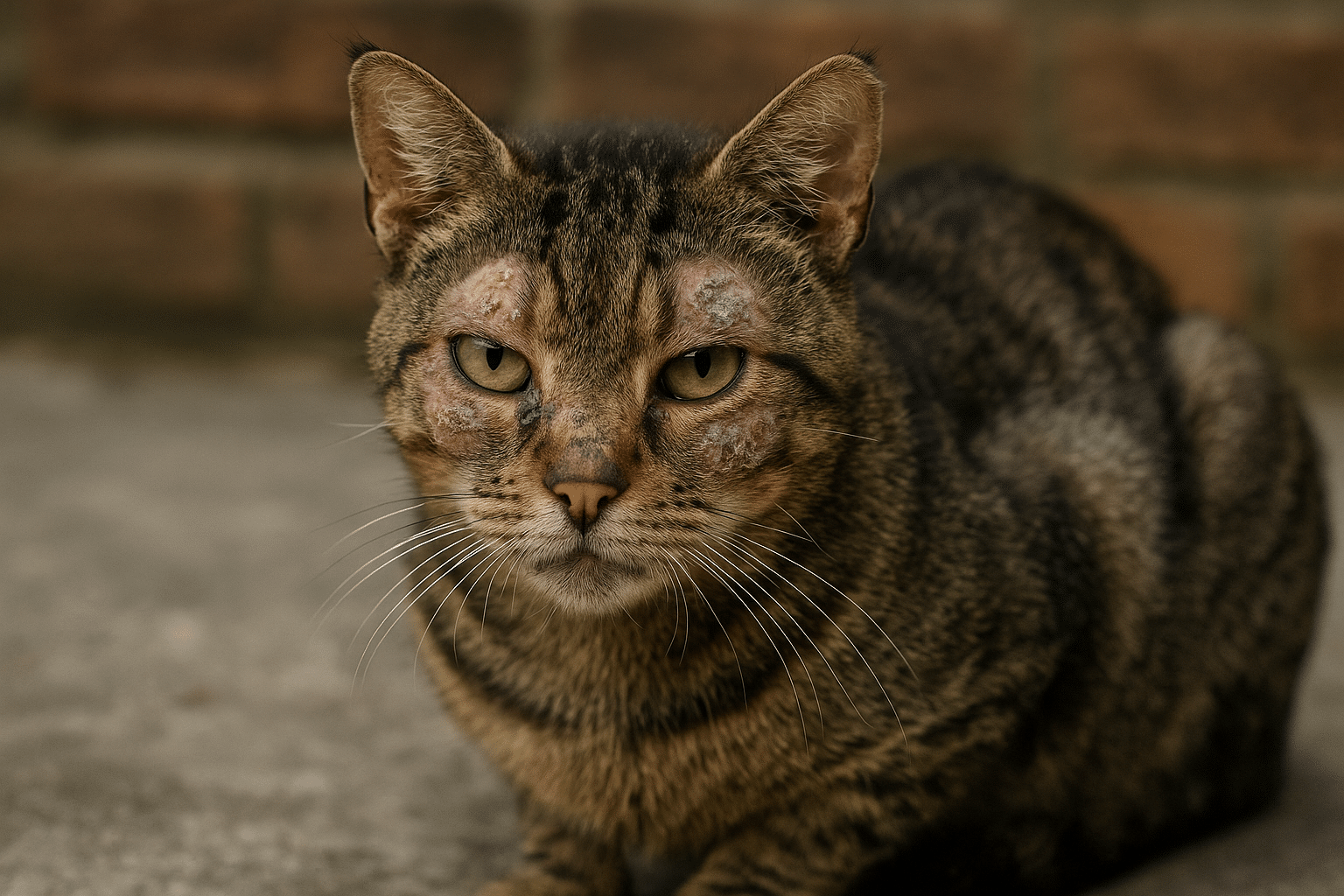Ringworm isn’t a worm at all—it’s a contagious skin fungus. The good news? With the right care, most cats recover beautifully. Here’s how to spot it fast, treat it gently, and keep your home (and family) protected.
Symptoms of ringworm in cats
Look for small, round patches of hair loss with scaly, reddened skin. The head, ears, and paws are classic spots, but lesions can show up anywhere.
Hairs may look broken or “moth-eaten,” and some cats scratch, while others don’t seem itchy at all. Whisker loss or brittle whiskers can also appear.
Surprising fact: certain strains glow apple-green under a Wood’s lamp (UV light)—but not all do, so a normal lamp test doesn’t rule it out.
Causes and how it spreads
Ringworm (feline dermatophytosis) is caused by fungi that live in hair and skin. It spreads by direct contact with an infected animal or by spores left on bedding, brushes, carpets, or furniture.
It’s zoonotic, meaning humans can catch it—especially children, seniors, and anyone with a weakened immune system. Wash hands after handling your cat and keep close face-to-fur cuddles limited until treatment is underway.
Some cats are “silent carriers” and shed spores without obvious lesions. That’s why household hygiene matters as much as medication.
Curious about other common issues and how to handle them? Explore other common cat health problems.
Diagnosis and treatment
Vets often combine methods: a physical exam, a Wood’s lamp check, hair or scale sampling, and fungal culture or PCR. Culture confirms the diagnosis and can guide treatment length.
Treatment usually pairs topical care with oral medication for best results:
- Topicals: antifungal shampoos, rinses, or creams (your vet will advise frequency).
- Orals: medications like itraconazole or terbinafine may be prescribed for several weeks.
Common mistake to avoid: stopping treatment as soon as the skin looks better. Spores can linger; ending therapy too early leads to setbacks and recontamination. Always follow your vet’s timeline and recheck plan.
Because baths may be part of the protocol, learn how to wash your cat safely without stress for either of you.
Want a reliable overview from a public health perspective? See the CDC’s guidance on ringworm in cats and dogs.
Home hygiene: stop spores in their tracks
Medication treats your cat; cleaning treats your home. Focus on reducing spores while treatment works.
- Vacuum frequently (HEPA if possible). Discard bags or clean canisters after use.
- Wash textiles on hot cycles when safe. Dry completely—heat helps.
- Disinfect hard surfaces with a vet-recommended product; never apply disinfectants to your cat.
- Limit your cat’s territory to a few easy-to-clean rooms during treatment.
Practical tip: set up a small “decontamination basket” by the cat’s room: a washable apron, house-only slippers, and a sticky lint roller. Roll your clothes and soft furnishings before leaving the room—fast, cheap, and surprisingly effective at trapping stray hairs and spores.
Keep an eye on overall wellbeing too. Here are the signs your cat is in good health so you can track progress confidently.
Living with a cat with ringworm
Comfort makes recovery easier. Offer a warm, quiet resting spot, gentle play to keep spirits up, and tasty meals to maintain energy. Enrichment (puzzle feeders, window perches) helps reduce stress—stress can slow skin healing.
Limit close contact between your cat and kids, seniors, or immunocompromised family members until your vet says it’s safe. Wash hands after handling and keep grooming tools separate.
Another pitfall: full-body shaving without veterinary guidance. It can irritate skin and spread spores. Targeted trimming around lesions is safer—and only if your vet recommends it.
If you’re refreshing your care routine, our guide to cat fleas pairs nicely with these hygiene habits.
Keeping your cat healthy and happy
Ringworm is common, treatable, and temporary with patience. Stick to the plan, clean steadily rather than obsessively, and celebrate small wins—a clearer patch of skin, fewer flakes, better appetite.
Your calm presence is medicine, too. You’ve got this, and your feline knows it.
FAQ
Is ringworm in cats contagious to humans?
Yes. It’s a zoonotic fungus. Good hand hygiene, limited close contact, and cleaning help protect your household until your vet confirms your cat is no longer contagious.
How long is a cat with ringworm contagious?
It varies, but many cats become less contagious after starting effective treatment and diligent cleaning. Your vet may recommend rechecks or cultures to confirm clearance.
Can ringworm go away on its own in cats?
Sometimes mild cases improve, but without treatment it can spread, persist, and infect other pets or people. Prompt vet care shortens recovery and reduces household contamination.
What kills ringworm spores at home?
Regular vacuuming, hot washing/drying of textiles, and appropriate disinfectants for hard surfaces are key. Always follow product labels and never use harsh chemicals on your cat.








